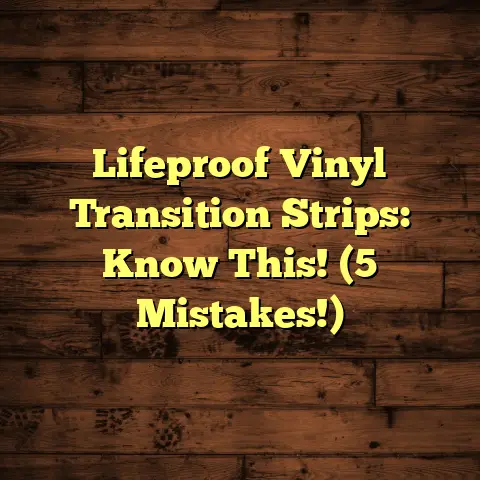Stop Creaking Floors DIY? (10 Board Rescue!)
For many of us, our homes are more than just places to live; they’re canvases for creativity.
And let’s be honest, there’s a real joy in making our spaces more comfortable and aesthetically pleasing.
But what happens when that joy is interrupted by a pesky problem like creaking floors?
It can be incredibly frustrating!
That’s why I want to share my expertise to help you tackle this issue head-on.
Let’s dive into the world of creaking floors and explore how you can silence those annoying sounds with a little DIY magic.
Section 1: Understanding Creaking Floors
So, what exactly are creaking floors?
Well, simply put, they’re floors that make noise when you walk on them.
The creaks, squeaks, and groans can be caused by several factors, including age, moisture, and the type of flooring material.
Think of it like this: your floorboards are constantly interacting with each other and the subfloor beneath them.
Over time, these interactions can lead to movement and friction, resulting in those telltale creaks.
As a flooring contractor with over 15 years of experience, I’ve seen creaking floors in all sorts of homes.
But certain areas tend to be more prone to creaking than others.
Hallways, staircases, and older homes are common culprits.
Why? Because these areas often experience high foot traffic and are more susceptible to the effects of time and moisture.
Section 2: Why Fixing Creaking Floors is Important
Now, you might be thinking, “It’s just a creak, what’s the big deal?”
But ignoring creaking floors can actually have some pretty significant implications.
For starters, those noises can be incredibly annoying!
They can disrupt your peace and quiet, especially if you’re trying to relax or concentrate.
But more importantly, creaking floors can be a sign of underlying structural issues.
They could indicate loose floorboards, damaged subflooring, or even problems with the joists that support your floor.
If left unaddressed, these issues can worsen over time, potentially leading to costly repairs down the road.
According to a recent survey by the National Association of Realtors, homes with noticeable maintenance issues, such as creaking floors, can sell for up to 10% less than comparable homes in good condition.
So, fixing those creaks isn’t just about improving your comfort; it’s also about protecting your investment.
And let’s not forget the emotional satisfaction that comes with completing a home improvement project.
There’s nothing quite like the feeling of accomplishment you get from tackling a problem and making your home a better place to live.
Section 3: Tools and Materials Needed for DIY Floor Repair
Alright, are you ready to roll up your sleeves and get to work?
Before we dive into the “10 Board Rescue” technique, let’s make sure you have all the necessary tools and materials.
Here’s a list of essentials:
- Screwdrivers: Both Phillips head and flathead screwdrivers will come in handy.
- Wood Glue: A high-quality wood glue will help secure loose joints.
- Flooring Nails: Choose nails that are appropriate for your flooring material.
- Hammer: For driving in those flooring nails.
- Shims: These thin, tapered pieces of wood will help level out creaky boards.
- Wood Filler: To fill any gaps or imperfections in the flooring.
- Replacement Boards: If any of your floorboards are beyond repair, you’ll need replacements.
- Safety Glasses: Protect your eyes from flying debris.
- Dust Mask: To avoid inhaling dust and particles.
- Caulk: To seal gaps and prevent movement.
- Stud Finder: To locate joists for secure fastening.
- Drill: For pre-drilling holes and driving screws.
- Circular Saw or Hand Saw: For cutting replacement boards to size.
Now, where can you find these tools and materials without breaking the bank?
I recommend checking out your local hardware store or home improvement center.
You can often find great deals on tools and materials, especially if you keep an eye out for sales and discounts.
Don’t forget to ask the staff for advice – they can help you choose the right products for your specific needs.
Section 4: The 10 Board Rescue Technique
Okay, now for the main event: the “10 Board Rescue” technique!
This method is designed to help you systematically address creaking floors by focusing on ten key areas.
Think of it as a comprehensive approach to silencing those annoying noises.
Here’s a brief overview of each board or area of focus:
- Identifying the Source of Creaking: Pinpoint the exact locations of creaks.
- Tightening Loose Floorboards: Secure screws and nails in floorboards.
- Using Shims: Level out creaky boards by inserting shims.
- Applying Wood Glue: Secure loose joints using wood glue.
- Reinforcing with Blocking: Install blocking between joists for extra support.
- Replacing Damaged Boards: Remove and replace floorboards beyond repair.
- Caulking Gaps: Reduce movement and noise by caulking gaps.
- Screwing Down the Subfloor: Fasten the subfloor securely to prevent creaks.
- Soundproofing Techniques: Reduce noise transmission using soundproofing methods.
- Finishing Touches: Refinish or paint repaired areas for a seamless look.
Let’s dive deeper into each of these areas:
1. Identifying the Source of Creaking
This is arguably the most important step in the entire process.
You need to pinpoint the exact locations of the creaks before you can start fixing them.
Walk around the room and listen carefully, paying attention to where the noises are coming from.
Sometimes, it can be tricky to identify the exact source of a creak.
Try having someone walk around while you listen closely from different angles.
You can also use a stethoscope or a simple listening device to help you narrow down the location.
Once you’ve identified the source of the creak, mark it with a piece of tape or chalk.
2. Tightening Loose Floorboards
Once you’ve identified the source of the creaks, the next step is to tighten any loose floorboards.
Over time, screws and nails can loosen, causing the floorboards to move and creak.
Using a screwdriver or a hammer, tighten any loose screws or nails that you find.
If the screws are stripped or the nails are bent, replace them with new ones.
Make sure to use screws or nails that are appropriate for your flooring material.
For hardwood floors, I recommend using flooring nails that are designed to prevent splitting.
3. Using Shims
Shims are thin, tapered pieces of wood that can be used to level out creaky boards.
They work by filling in gaps between the floorboards and the subfloor, preventing movement and noise.
To use shims, simply insert them into the gaps beneath the creaky boards.
You may need to use a hammer to gently tap the shims into place.
Be careful not to force the shims in too far, as this could damage the floorboards.
Once the shims are in place, test the area to see if the creaking has stopped.
If not, add more shims until the floor is level and the noise is gone.
4. Applying Wood Glue
Wood glue is a great way to secure loose joints and prevent creaking.
It works by bonding the floorboards together, creating a strong and stable connection.
To apply wood glue, start by cleaning the area around the loose joint.
Remove any dust, dirt, or debris that could interfere with the adhesion of the glue.
Then, apply a small amount of wood glue to the joint.
Use a clamp or weight to hold the joint together while the glue dries.
Allow the glue to dry completely before walking on the area.
5. Reinforcing with Blocking
Blocking is a technique that involves installing pieces of wood between the joists that support your floor.
This adds extra support to the floor and helps to prevent creaking.
To install blocking, start by measuring the distance between the joists.
Then, cut pieces of wood to fit snugly between the joists.
Apply wood glue to the ends of the blocking and insert them between the joists.
Secure the blocking with screws or nails.
6. Replacing Damaged Boards
Sometimes, floorboards are simply too damaged to be repaired.
In these cases, the best option is to replace them with new boards.
To replace a damaged floorboard, start by removing it from the floor.
You may need to use a pry bar or a chisel to loosen the board.
Be careful not to damage the surrounding floorboards.
Once the damaged board is removed, measure the opening and cut a new board to fit.
Apply wood glue to the edges of the new board and insert it into the opening.
Secure the new board with screws or nails.
7. Caulking Gaps
Gaps between floorboards can also contribute to creaking.
By caulking these gaps, you can reduce movement and noise.
To caulk gaps, start by cleaning the area around the gap.
Remove any dust, dirt, or debris that could interfere with the adhesion of the caulk.
Then, apply a bead of caulk to the gap.
Smooth the caulk with your finger or a damp cloth.
Allow the caulk to dry completely before walking on the area.
8. Screwing Down the Subfloor
A loose subfloor can also cause creaking.
To prevent this, make sure that the subfloor is securely fastened to the joists.
Use screws to attach the subfloor to the joists.
Space the screws evenly across the subfloor.
If you’re not sure where the joists are located, use a stud finder to find them.
9. Soundproofing Techniques
If you want to go the extra mile, you can use soundproofing techniques to further reduce noise transmission.
One popular technique is to install a layer of soundproofing material between the subfloor and the finished floor.
This material can help to absorb sound and prevent it from traveling through the floor.
10. Finishing Touches
Once you’ve completed all of the necessary repairs, it’s time to add the finishing touches.
This may involve refinishing or painting the repaired areas to match the existing flooring.
If you’re refinishing the floor, start by sanding the area to remove any imperfections.
Then, apply a stain or finish to match the existing flooring.
If you’re painting the floor, start by priming the area.
Then, apply several coats of paint, allowing each coat to dry completely before applying the next.
Section 5: Step-by-Step Guide to Implementing the 10 Board Rescue
Okay, now that we’ve covered all the individual techniques, let’s put it all together with a step-by-step guide to implementing the 10 Board Rescue:
- Gather Your Tools and Materials: Make sure you have everything you need before you start.
- Identify the Source of Creaking: Walk around the room and pinpoint the exact locations of the creaks. Mark them with tape or chalk.
- Tighten Loose Floorboards: Tighten any loose screws or nails in the creaky areas. Replace any stripped or bent fasteners.
- Use Shims: Insert shims into the gaps beneath the creaky boards to level them out.
- Apply Wood Glue: Apply wood glue to any loose joints and clamp or weigh them down while the glue dries.
- Reinforce with Blocking: Install blocking between the joists to add extra support to the floor.
- Replace Damaged Boards: If any floorboards are beyond repair, remove and replace them with new boards.
- Caulk Gaps: Caulk any gaps between floorboards to reduce movement and noise.
- Screw Down the Subfloor: Ensure the subfloor is securely fastened to the joists with screws.
- Apply Soundproofing (Optional): Install a layer of soundproofing material between the subfloor and the finished floor.
- Finishing Touches: Refinish or paint the repaired areas to match the existing flooring.
Troubleshooting Tips:
- Creak Persists: If the creaking persists after trying these techniques, you may need to consult a professional flooring contractor.
- Difficult Access: If you have difficulty accessing the subfloor, you may need to remove some of the flooring to gain access.
- Matching Existing Flooring: If you’re replacing floorboards, be sure to choose boards that match the existing flooring in terms of species, color, and grain.
Section 6: Maintenance Tips for Preventing Future Creaks
Prevention is always better than cure! Here are some maintenance tips to help prevent future floor creaking:
- Control Moisture: Keep your home’s humidity levels consistent to prevent wood from expanding and contracting, which can lead to creaks. A dehumidifier or humidifier can help.
- Regular Inspections: Periodically inspect your floors for loose boards, gaps, or other signs of damage. Address these issues promptly.
- Proper Cleaning: Use cleaning products that are specifically designed for your flooring type. Avoid using excessive water, which can damage wood floors.
- Avoid Excessive Weight: Avoid placing excessive weight on certain areas of the floor, as this can stress the floorboards and lead to creaking.
- Professional Maintenance: Consider having your floors professionally inspected and maintained every few years.
Conclusion
So, there you have it: the “10 Board Rescue” technique for silencing those annoying creaking floors!
I hope this article has empowered you to tackle this project yourself and transform your living space.
Remember, DIY home improvement is not just about fixing problems; it’s about expressing your creativity and making your home a reflection of your personal style.
Embrace your inner hobbyist, take on this project, and enjoy the satisfaction of creating a more comfortable and enjoyable home environment.
Call to Action
Now, I’d love to hear from you! Have you ever tackled a DIY flooring project?
What tips or tricks have you learned along the way?
Share your experiences in the comments below! Let’s build a community of DIY enthusiasts who are passionate about transforming their homes.
And don’t forget to share photos or stories of your successful floor repairs – we’d love to see your amazing work!





